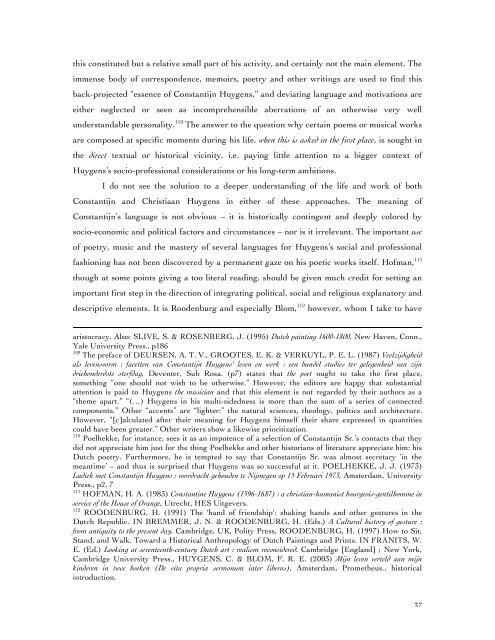Christiaan Huygens – A family affair - Proeven van Vroeger
Christiaan Huygens – A family affair - Proeven van Vroeger
Christiaan Huygens – A family affair - Proeven van Vroeger
You also want an ePaper? Increase the reach of your titles
YUMPU automatically turns print PDFs into web optimized ePapers that Google loves.
this constituted but a relative small part of his activity, and certainly not the main element. The<br />
immense body of correspondence, memoirs, poetry and other writings are used to find this<br />
back-projected “essence of Constantijn <strong>Huygens</strong>,” and deviating language and motivations are<br />
either neglected or seen as incomprehensible aberrations of an otherwise very well<br />
understandable personality. 110 The answer to the question why certain poems or musical works<br />
are composed at specific moments during his life, when this is asked in the first place, is sought in<br />
the direct textual or historical vicinity, i.e. paying little attention to a bigger context of<br />
<strong>Huygens</strong>’s socio-professional considerations or his long-term ambitions.<br />
I do not see the solution to a deeper understanding of the life and work of both<br />
Constantijn and <strong>Christiaan</strong> <strong>Huygens</strong> in either of these approaches. The meaning of<br />
Constantijn’s language is not obvious <strong>–</strong> it is historically contingent and deeply colored by<br />
socio-economic and political factors and circumstances <strong>–</strong> nor is it irrele<strong>van</strong>t. The important use<br />
of poetry, music and the mastery of several languages for <strong>Huygens</strong>’s social and professional<br />
fashioning has not been discovered by a permanent gaze on his poetic works itself. Hofman, 111<br />
though at some points giving a too literal reading, should be given much credit for setting an<br />
important first step in the direction of integrating political, social and religious explanatory and<br />
descriptive elements. It is Roodenburg and especially Blom, 112 however, whom I take to have<br />
aristocracy. Also: SLIVE, S. & ROSENBERG, J. (1995) Dutch painting 1600-1800, New Haven, Conn.,<br />
Yale University Press., p186<br />
109 The preface of DEURSEN, A. T. V., GROOTES, E. K. & VERKUYL, P. E. L. (1987) Veelzijdigheid<br />
als levensvorm : facetten <strong>van</strong> Constantijn <strong>Huygens</strong>' leven en werk : een bundel studies ter gelegenheid <strong>van</strong> zijn<br />
driehonderdste sterfdag, Deventer, Sub Rosa. (p7) states that the poet ought to take the first place,<br />
something “one should not wish to be otherwise.” However, the editors are happy that substantial<br />
attention is paid to <strong>Huygens</strong> the musician and that this element is not regarded by their authors as a<br />
“theme apart.” “(…) <strong>Huygens</strong> in his multi-sidedness is more than the sum of a series of connected<br />
components.” Other “accents” are “lighter:” the natural sciences, theology, politics and architecture.<br />
However, “[c]alculated after their meaning for <strong>Huygens</strong> himself their share expressed in quantities<br />
could have been greater.” Other writers show a likewise prioritization.<br />
110 Poelhekke, for instance, sees it as an impotence of a selection of Constantijn Sr.’s contacts that they<br />
did not appreciate him just for the thing Poelhekke and other historians of literature appreciate him: his<br />
Dutch poetry. Furthermore, he is tempted to say that Constantijn Sr. was almost secretary ‘in the<br />
meantime’ <strong>–</strong> and thus is surprised that <strong>Huygens</strong> was so successful at it. POELHEKKE, J. J. (1973)<br />
Ludiek met Constantijn <strong>Huygens</strong> : voordracht gehouden te Nijmegen op 15 Februari 1973, Amsterdam, University<br />
Press., p2, 7<br />
111 HOFMAN, H. A. (1983) Constantine <strong>Huygens</strong> (1596-1687) : a christian-humanist bourgeois-gentilhomme in<br />
service of the House of Orange, Utrecht, HES Uitgevers.<br />
112 ROODENBURG, H. (1991) The 'hand of friendship': shaking hands and other gestures in the<br />
Dutch Republic. IN BREMMER, J. N. & ROODENBURG, H. (Eds.) A Cultural history of gesture :<br />
from antiquity to the present day. Cambridge, UK, Polity Press, ROODENBURG, H. (1997) How to Sit,<br />
Stand, and Walk. Toward a Historical Anthropology of Dutch Paintings and Prints. IN FRANITS, W.<br />
E. (Ed.) Looking at seventeenth-century Dutch art : realism reconsidered. Cambridge [England] ; New York,<br />
Cambridge University Press., HUYGENS, C. & BLOM, F. R. E. (2003) Mijn leven verteld aan mijn<br />
kinderen in twee boeken (De vita propria sermonum inter liberos), Amsterdam, Prometheus., historical<br />
introduction.<br />
37


